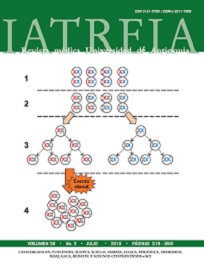Relapsing and difficult to control hypokalemia in a patient with acute lymphoid leukemia
DOI:
https://doi.org/10.17533/udea.iatreia.v28n3a09Keywords:
Acute lymphoid leukemia, flaccid paralysis, hypokalemia, lysozymuriaAbstract
Hypokalemia is an electrolytic disorder, in some occasions difficult to control. When severe, it may be life-threatening. We report the case of a patient with relapse of acute lymphoid leukemia, who presented to the hospital with flaccid paralysis associated with severe hypokalemia. The cause was a tubulopathy associated with leukemic infiltration of the kidneys.
Downloads
References
(1.) Filippatos TD, Milionis HJ, Elisaf MS. Alterations in electrolyte equilibrium in patients with acute leukemia. Eur J Haematol. 2005 Dec;75(6):449-60.
(2.) O'Regan S, Carson S, Chesney RW, Drummond KN. Electrolyte and acid-base disturbances in the management of leukemia. Blood. 1977 Mar;49(3):345-53.
(3.) Munker R, Hill U, Jehn U, Kolb HJ, Schalhorn A. Renal complications in acute leukemias. Haematologica. 1998 May;83(5):416-21.
(4.) Gennari FJ. Hypokalemia. N Engl J Med. 1998 Aug;339(7):451-8.
(5.) Mandal AK. Hypokalemia and hyperkalemia. Med Clin North Am. 1997 May;81(3):611-39.
(6.) Gennari FJ. Disorders of potassium homeostasis. Hypokalemia and hyperkalemia. Crit Care Clin. 2002 Apr;18(2):273-88.
(7.) Marti G, Schwarz C, Leichtle AB, Fiedler GM, Arampatzis S, Exadaktylos AK, et al. Etiology and symptoms of severe hypokalemia in emergency department patients. Eur J Emerg Med. 2014 Feb;21(1):46-51.
(8.) Reimann D, Gross P. Chronic, diagnosis-resistant hypokalaemia. Nephrol Dial Transplant. 1999 Dec;14(12):2957-61.
(9.) Lin SH, Lin YF, Halperin ML. Hypokalaemia and paralysis. QJM. 2001 Mar;94(3):133-9.
(10.) Bagley WH, Yang H, Shah KH. Rhabdomyolysis. Intern Emerg Med. 2007 Oct;2(3):210-8.
(11.) Yelamanchi VP, Molnar J, Ranade V, Somberg JC. Influence of electrolyte abnormalities on interlead variability of ventricular repolarization times in 12-lead electrocardiography. Am J Ther. 2001 Mar-Apr;8(2):117-22.
(12.) Greenlee M, Wingo CS, McDonough AA, Youn JH, Kone BC. Narrative review: evolving concepts in potassium homeostasis and hypokalemia. Ann Intern Med. 2009 May;150(9):619-25.
(13.) Wang WH, Giebisch G. Regulation of potassium (K) handling in the renal collecting duct. Pflugers Arch. 2009 May;458(1):157-68.
(14.) Liu T, Nagami GT, Everett ML, Levine BS. Very low calorie diets and hypokalaemia: the importance of ammonium excretion. Nephrol Dial Transplant. 2005 Mar;20(3):642-6.
(15.) Stewart PM. Mineralocorticoid hypertension. Lancet. 1999 Apr;353(9161):1341-7.
(16.) Mattsson C, Young WF Jr. Primary aldosteronism: diagnostic and treatment strategies. Nat Clin Pract Nephrol. 2006 Apr;2(4):198-208.
(17.) Rossi GP, Bernini G, Caliumi C, Desideri G, Fabris B, Ferri C, et al. A prospective study of the prevalence of primary aldosteronism in 1,125 hypertensive pa-tients. J Am Coll Cardiol. 2006 Dec;48(11):2293-300.
(18.) Torpy DJ, Mullen N, Ilias I, Nieman LK. Association of hypertension and hypokalemia with Cushing's syndrome caused by ectopic ACTH secretion: a series of 58 cases. Ann N Y Acad Sci. 2002 Sep;970:134-44.
(19.) Tsai CS, Chen YC, Chen HH, Cheng CJ, Lin SH. An unusual cause of hypokalemic paralysis: aristolochic acid nephropathy with Fanconi syndrome. Am J Med Sci. 2005 Sep;330(3):153-5.
(20.) Abraham BP, Sellin JH. Drug-induced, factitious, & idiopathic diarrhoea. Best Pract Res Clin Gastroenterol. 2012 Oct;26(5):633-48.
(21.) Papademetriou V. Diuretics, hypokalemia, and cardiac arrhythmia: a 20-year controversy. J Clin Hyper-tens (Greenwich). 2006 Feb;8(2):86-92.
(22.) Lin SH, Lin YF, Chen DT, Chu P, Hsu CW, Halperin ML. Laboratory tests to determine the cause of hypokalemia and paralysis. Arch Intern Med. 2004 Jul;164(14):1561-6.
(23.) Groeneveld JH, Sijpkens YW, Lin SH, Davids MR, Halperin ML. An approach to the patient with severe hypokalaemia: the potassium quiz. QJM. 2005 Apr;98(4):305-16.
(24.) Wiederseiner JM, Muser J, Lutz T, Hulter HN, Krapf R. Acute metabolic acidosis: characterization and diagnosis of the disorder and the plasma potassium response. J Am Soc Nephrol. 2004 Jun;15(6):1589-96.
(25.) Gladziwa U, Schwarz R, Gitter AH, Bijman J, Seyberth H, Beck F, et al. Chronic hypokalaemia of adults: Gitelman's syndrome is frequent but classical Bartter's syndrome is rare. Nephrol Dial Transplant. 1995;10(9):1607-13.
(26.) Kobayashi T, Muto S, Nemoto J, Miyata Y, Ishiharajima S, Hironaka M, et al. Fanconi's syndrome and distal (type 1) renal tubular acidosis in a patient with primary Sjögren's syndrome with monoclonal gammopathy of undetermined significance. Clin Ne-phrol. 2006 Jun;65(6):427-32.
(27.) Rodríguez Soriano J. Renal tubular acidosis: the clinical entity. J Am Soc Nephrol. 2002 Aug;13(8):2160-70.
(28.) Harrison JF, Parker RW, De Silva KL. Lysozymuria and acute disorders of renal function. J Clin Pathol. 1973 Apr;26(4):278-84.
(29.) Morris RC Jr, Sebastian A. Alkali therapy in renal tubular acidosis: who needs it? J Am Soc Nephrol. 2002 Aug;13(8):2186-8.
Downloads
Published
How to Cite
Issue
Section
License
Copyright (c) 2015 Iatreia

This work is licensed under a Creative Commons Attribution-ShareAlike 4.0 International License.
Papers published in the journal are available for use under the Creative Commons license, specifically Attribution-NonCommercial-ShareAlike 4.0 International.
The papers must be unpublished and sent exclusively to the Journal Iatreia; the author uploading the contribution is required to submit two fully completed formats: article submission and authorship responsibility.














